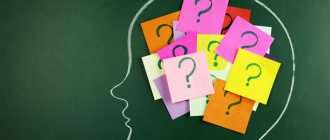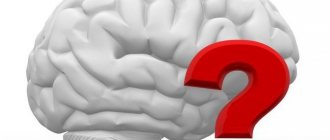The process of memorization involves several types of memory, which are developed differently in each person. Some people find it easier to learn material by listening to it, while others have a more intense visual memory. We looked at what factors influence the memorization process in this article, now let’s talk about how to develop memory, depending on your existing capabilities and needs. Is it possible to develop memory?
Visual memory
In the process of human life, the most significant is visual memory. It is with its help that most of the information is recorded during training and work, so it is not surprising that the desire and desire to develop visual reproduction.
Let's consider several exercises that will help develop memory in both an adult and a child.
- Aivazovsky's method - look at an object for 3 seconds, try to remember it in the smallest detail. Close your eyes, imagine this object taking into account all the available nuances. Repeat the exercise several times. Perhaps the first time you will understand that small details are not remembered at all, but with each subsequent training the result will be better.
- Exercise “Observer” - take a bright thing, for example an apple, look at it, remember. Close your eyes and mentally reproduce the picture.
Note: A fruit that develops memory is an apple. It contains phytonutrients resveratrol and epigallocatechin-3-gallate, which promote the formation of new neurons.
- Exercise “Artist” - take an object from the previous exercise and draw it, trying to reproduce all the details.
- Exercise “Emphasis on detail” - you can practice remembering a stranger. But you should not record everything at once; pay attention to some specific details. For example, if you remember a face, then focus on the color of the eyes, the shape of the nose, chin, etc. If you took a building as an object - the shape of the roof, the number of doors, windows, colors, etc.
- Exercise “Mysterious animal” - all people are somewhat similar to animals. This can be used for memorization. Choose the image “bird profile”, “cat walk”, “fox look”, etc.
- “Spot the Differences” is an exercise that can be done either using pictures or in an environment. Remember how the objects are located on your colleague’s desk, ask him to make a few changes, find what exactly is located differently, maybe some new objects have appeared, or, conversely, some of them have disappeared. The same can be done with the arrangement of books or folders on a shelf, a person’s appearance, etc.
The peculiarity of this training system is that the exercises must be done regularly. It is not necessary to choose a specific time for this, to prepare, to tune in; they can be performed in everyday activities. For example, you are on your way to work, you meet a stranger, do the “Emphasis on detail” or “Mysterious animal” exercise. And memorizing objects is generally a minute-long activity, drink coffee, do an exercise, because changing the type of activity is also relaxation.
But it is important to know not only how to develop visual memory, its other types in some types of work activity are also of great importance.
How to train long-term memory
To train long-term memory, similar exercises are used, aimed at storing data for a longer time. An effective method is constant repetition of information. Learn poems or special materials for work and study by heart
It doesn’t matter what, the main thing is the process of concentrating on what you are learning. For better assimilation, speak the information out loud and in your head.
Here are some exercises that will help you develop your long-term memory:
- Make a wish for an object that you see several times a day and try to visualize it - remember its quality properties, appearance. Make the description as accurate as possible.
- Make a list of things to do for the day on paper in random order. Remember it, and during the day, without resorting to writing, organize these tasks in a sequence that is productive for you.
- Choose the picture that you like best. Describe what you see on it. The next day, in addition to remembering the previous description, you must supplement it with new characteristics. Do the same the next day. When you realize that you have run out of ideas for describing the painting, move on to a new one.
Auditory memory
While studying at school or university, teachers always explain new material.
And the lucky ones are those who perfectly remember the information they listened to. They need less time to prepare homework, since most of the information has already been learned. A reasonable question is how to develop auditory memory in order to make your life and work much easier? Auditory memory training:
- Listen to the conversations of random passers-by, passengers in transport, try to remember the information. At first glance, this seems like an easy task, but if this type of brain function is poorly developed, you will have to try to remember at least something.
- How else to develop auditory memory in an adult? When you hear an unfamiliar voice, try to imagine his portrait without looking at the person. Then compare the result. This exercise not only helps train memory, but also promotes the development of logic, attention, and intuition.
- “Pop music” - turn on a song you know, listen to a short fragment, turn off the sound, continuing to hum the words. Turn on the sound again - does what is playing match what you stopped at?
- It's helpful to listen to your favorite movies and TV shows at a low volume. This exercise trains hearing, attentiveness, and concentration.
- If you like to read, recite the material you read out loud. Or if someone in your family is interested in such an activity, ask him to read aloud, try to remember what he heard. Or you can simply listen to audiobooks while doing household chores.
- Ask someone to clap or tap a simple rhythm and try to repeat it. Start the exercise with 5-7 claps (tapping), gradually making it more difficult.
- Say a few numbers out loud (four at first), repeat them in reverse order. Gradually include two-digit, three-digit numbers, etc. in your number series.
Having mastered simple techniques on how to develop auditory memory for an adult, we move on to the next type.
Simple tasks
The mechanisms of memory are still being studied by neuroscientists. Experts have proven that several areas of the brain are responsible for remembering and reproducing information, which need to be regularly trained. Even ancient Greek thinkers did this. They came up with various exercises to develop memory. Many of them are used by modern people, but there are also activities that have appeared recently.
It is difficult to name the best exercises for memory development. Different types of training can influence mental processes and increase the speed and quality of memorizing the necessary information. Simple exercises are suitable for both children and adults:
- Puzzles with differences. Pictures that depict almost identical drawings, but with some differences, help develop memory and attentiveness. This game seems like a child's game, but for adults they make illustrations with many details. For children, simpler images are selected.
- Poems and songs. From childhood, children are taught to memorize rhyming lines. If you memorize rhymes or songs often, your memory will improve over time. Of course, it is easier to work with materials that you love, but students should choose information that is relevant to their lessons.
- Writing words. This method helps train linear memory. Write down 10-15 words on a sheet of paper, which are re-read to yourself or out loud several times. Then you need to turn the paper over and write everything you remember. You should also try to write them down in order. Or you can create a table of several rows and columns and then transfer it to a new sheet from memory. Over time, the list of words increases.
- "Backwards". An effective technique can improve short-term memory. A person memorizes three simple words in a row and then reads them backwards. Having mastered the task, you can move on to phrases and sentences.
- Retelling. This method helps train memory and reading. A child or teenager first needs to read short texts or paragraphs and then retell them. Then you should move on to whole pages. Retelling books helps not only to train memorization, but also provides an opportunity to learn about something new or reflect on some things.
Brain training | Memory training exercises
Watch this video on YouTube
Verbal-logical memory
Verbal-logical (verbal) memory is our ability to remember and reproduce thoughts, texts, phrases of other people, etc. Why is it necessary to develop memory in this capacity? This type of memorization is of great importance in the learning process and mastering new material.
Exercises for developing verbal memory:
- One of the simplest and most accessible ways to develop verbal-logical memory is reading and retelling texts .
- Write several pairs of words in a column on a piece of paper, in each of which they are connected in meaning, for example, book - story, cow - milk, dining room - dish, etc. Cover the right column with a piece of paper or your hand, read the remaining open words and try to remember the hidden pair. Increase the chain with each workout.
- Ask someone close to you to read a list of 15 unrelated words. Try to repeat them. To make it easier to remember, build an associative series, or connect the words with each other according to their meaning.
For example: cow-table-phone-keyboard…. can be imagined as follows: a cow was sitting on the table, holding the phone and clicking on the keyboard...
- Learn poetry, the best way to develop memory is constant training.
- Exercise “Pictograms”:
- Read the text
- Highlight key words or phrases in the text.
- Assign any picture to each phrase - create an association.
- Link the resulting pictures into a cartoon or a clip.
- Look at the pictures and reproduce the text.
- Use online exercises, such as Vikium.
Instructions on how to remember the text
- Read and understand the material you need to remember. The most important factor is UNDERSTANDING. It is impossible to remember for a long time what you do not understand, because associative connections are not built in memory.
- Write down what you read . Without looking at the source, try to summarize the remembered information in your own words.
- Repeat points 1 and 2 several times . Re-read and write down the text as many times as possible until you are satisfied with the result.
- Review the material you learned after 30 minutes .
- repeat the information again in an hour .
- To transfer the learned data to the long-term department, repeat what you learned the next day .
The above techniques will help you not only develop memory, but also other brain functions: logic, thinking, attentiveness.
Memory training in older people
In old age, brain function noticeably weakens. This is due to the fact that the ability of nerve cells to respond to external and internal stimuli decreases, as a result of which brain activity decreases. In addition to deterioration in memory, there is also a loss of concentration. But this does not mean that these processes are a consequence of the disease, or that the situation cannot be improved. Let's look at ways to train memory in older people:
- Collect puzzles. Choose the picture you like and go ahead! Just don't start with large and complex ones, because they may be difficult to assemble, and you will get tired of such an activity.
- Before you go to bed, sort through the events of your day: remember the things you did, who you met, what you talked about. The more detail you remember, the better.
- Come up with 5-10 words for each letter of the alphabet. This exercise will take time, but at the end of it you will feel the active work of your brain!
- Play board games - chess or checkers. Pay special attention to concentration when coming up with moves. Solve crosswords, scanwords. By playing for 30 minutes every day, you will activate your attention and memory process.
Emotional memory
How to develop memory in an adult - use emotions, some details are better imprinted if the event caused a storm of feelings. Emotions help you remember events that happened to you once, even though the level of sensitivity to these events decreases over time.
The peculiarity of this type of memory is that a person remembers three feelings especially vividly:
- fear;
- suffering;
- astonishment.
That is, we remember situations that have a negative connotation longer and more clearly than positive ones.
Developing emotional memory in adults exercises:
- Keep a diary in which you write down your emotions and experiences. Sometimes re-read it, trying to reproduce events based on the feelings you experienced.
- Periodically recall various positive events in your life, trying to feel the same emotions.
- Form a positive emotional state by reading the right books or watching good movies. Try to feel the state of the main characters. Based on these emotions, you can easily reproduce the content or plot.
The development of emotional memory will prevent negative events. In case of a previously experienced negative experience, it acts as a kind of stop signal that prevents you from committing erroneous actions.
Exercises for memory development
We bring to your attention games aimed at developing types of memory according to the classification of P.P. Blonsky.
Motor memory
Repeat the movement.
Invite your child to play a game. You show a movement (or sequence of movements) - the child needs to reproduce it. As you master it, complicate the movements, add new ones, and you can learn the dance.
Draw and remember.
Prepare a piece of paper, a simple pencil and a set of ten simple words familiar to the child. For example: house, picture, dog, holiday, walk, lunch, glasses, friendship, playground, joy. Instructions: “Now I will tell you words, and you quickly sketch them on a piece of paper so that you can remember them later. Your drawing should help you in the end. You will look at him and you will be able to name all the words that I say. Try to work quickly, do not spend a lot of time on the quality of the drawing. The main thing is that it should help you remember. Are you ready? Begin". Pronounce the words clearly and loudly so that the child can hear. Give time to make a small drawing and move on to the next word.
The younger the child, the fewer words should be used. Try to start with a number of words equal to the child's age. If the child copes with it easily, feel free to add more words.
Emotional memory
Thanks to positive emotions, the ability to remember information improves
Therefore, it is very important when communicating with a child: to encourage, share these emotions with him, live through the situation, be there and be ready to accept that the child also experiences emotions
To develop emotional memory, excellent exercise options would be:
- Playing scenes using a glove theater
- Learning songs with dramatization
- Reading and Memorizing Poems
- Psycho-gymnastics
- Mimic gymnastics and pantomime
Olfactory memory
Smell is a great memory stimulant. According to experts, olfactory memory is much stronger than visual and auditory memory. This is due to the peculiarities of the structure of the brain. You've probably caught yourself more than once thinking about how some smell immersed you in memories, while a whole chain of events unfolded before your eyes, or a feeling of pleasant, warm nostalgia arose.
According to scientific research, association with a certain smell helps to better remember information. For example, when preparing for an exam, using an incense stick can increase memory efficiency by 30%. It is enough to remember this scent (if it is not possible to reproduce it in reality).
To train your olfactory memory, do the following simple exercises:
- Try to imagine the smell of orange, rose, chocolate, or your favorite perfume.
- Try to remember objects by smell.
This is interesting: In some cases, memory in patients with amnesia is restored when the association with a certain smell is triggered.
Memory training is good for health
Exercises that involve the centers of brain activity not only give the effect of getting used to the loads, but also create additional synapses between brain cells. In parallel with this, a nutrient network of microcapillaries spreads, providing the nervous tissues with a sufficient amount of oxygen and energy substances. This “live” activity has a positive effect on the restoration of previously lost synaptic connections and prevents cell destruction.
According to the observations of doctors around the world, mental training in old age significantly improves the condition of the nervous system and prevents the development of diseases associated with the degradation of the structural elements of the brain. In other words, such activities are the key to a clear mind and good memory until old age.
At an earlier age, the healthy functioning of the nervous system should also not be neglected, since it is psychosomatic diseases that are becoming progressively widespread among young and middle-aged people and this is associated with an abnormal load on an unprepared nervous system, and often this leads to irreparable disorders of the functionality of the whole organism. Simple memory training reduces the stress of external stimuli and makes daily tasks easier, keeping the mind fresh and focused.
Motor memory
Motor memory is important not only for dancers or athletes, it is relevant for any person in the process of memorizing material. For example, when you type text on a computer, having the skill of fast typing, you concentrate your attention on the information, and not on hitting the right letters with your fingers, which significantly increases the level of mastering and memorizing data.
Note: How else can you quickly remember information? Associate information that needs to be recorded for a long time with a specific gesture. Thus, subsequently making this movement, you will be able to reproduce the necessary information.
But motor memory is of greatest importance for people whose work involves performing precise and complex movements: surgeons, musicians, dancers, etc. Developing motor memory is somewhat more difficult than its other types; you will need patience and willpower, but the main thing is still this In fact, it's practice.
How to develop motor memory:
- If the goal is to acquire a certain skill, you will have to repeat the same action so many times until it reaches the “reflex level.” The main condition is to carry out the algorithm of actions clearly and correctly, concentrating on the information or on the actions themselves.
- Exercise “Mushroom Glade”:
one hand is a mushroom, clench it into a fist and extend it in front of you
the second hand is a clearing, place your palm under an imaginary mushroom.
Your task is to suddenly change hands, turning a mushroom into a clearing, and a clearing into a mushroom, while your shoulders remain in place, your forearms, hands and fingers are involved. Speed up your movements each time.
- Stretch your arms in front of you and at the same time begin to rotate in different directions. As soon as it starts to feel free, change direction.
Note: Use motor memory if you need to learn a lecture: rewrite it or read it out loud.
Long-term memory: what is it?
Long-term memory retains received data for many years. Memories, once in the brain's long-term storage, are reproduced many times without being lost. The more often and regularly a memory is repeated in a person’s mind, the stronger and more accurate it becomes. This allows you to recall the necessary situation at a convenient time.
Using a long-term storage of memories, a person is forced to think and use willpower, so the good functioning of this area of the brain practically interacts with these factors.
How to develop long-term memory
The method of memorization primarily depends on what kind of memory you want to use, long-term or short-term. Will you need the information in the future, or is it only needed at this point in time? For example, you entered a confirmation code to enter your personal bank account, and you do not need to remember it further, but you need to remember the password for this account for a long time, otherwise you will not be able to use the organization’s services.
How to develop memory using the above exercises:
- Repeat the learned poems after a few days, a week and a month.
- Try to retell the book you read or the movie you watched in a week or a month.
- Any information received must be periodically refreshed so that it is stored in long-term memory.
In order for the learned material to be retained in memory for a long time, it is important to follow a few simple rules :
- information intended for memorization must be comprehended and systematized, for example, distributed into semantic blocks;
- interesting and interesting data is remembered automatically;
- knowledge of professional terminology for the material that needs to be learned;
- make settings for the time of memorization and control - brain programming greatly facilitates the memorization process, for example, plan where and when you may need this material;
- when studying, use the additional means mentioned above - associations, smells, emotions, etc.;
- do not forget to forget unnecessary information, yes, you understood correctly, do not clutter your head with unnecessary data.
As you know, long-term memory stores information that we periodically access. Use this rule, for example, disable the function of automatic password entry in social networks, mail and other instant messengers, enter it manually, this is especially useful if the passwords are different for all your accounts.
How to improve long-term memory?
To do this, practice the following:
- Play sports
and spend time outdoors. This will help enrich the brain with oxygen. - Don't overload yourself
with unnecessary information. Try to always stay positive and focus less on your worries. - Follow a
daily routine. - Meet with friends
more often and talk with them. - Get at least 6-7 hours of sleep
.
The following exercises are suitable for training long-term memory:
- Detail of what was seen.
To do this, you need to observe those around you, select an object and carefully examine it. Next, you need to mentally reproduce in detail what you saw earlier. - Learning poems by heart.
This also includes memorizing dialogues and texts. Assimilation of unfamiliar information generates new neural connections. - Organizing data in storage into shelves.
As a storage space, we usually choose a space that is familiar to us - an apartment, a house, a work office. This takes into account the sequence of your movement along it. Typically, the method is used to memorize unrelated words. For example, we give a person the lexemes ball, bread, basket, glass, roller. He imagines that the ball is in the hallway, the bread is on the table in the kitchen, the basket is in the toilet, the glass is inserted into the window in the bedroom, and the roller is placed in the corner of the children's room. - Passing memory games.
Among the most famous: “Memory Matrix”, “Top Secret”.
How to develop short-term memory
Now let's look at how to develop short-term memory in adults. The easiest way is to use applications on your phone aimed at training this brain function. For example, memorizing a number series that is shown on the screen for a few seconds, and as the result improves, the number of digits increases.
In addition, you can develop short-term memory simply by walking down the street: look at any object or person for a few seconds, try to remember all the details as accurately as possible, turn in the other direction and mentally reproduce the picture. If possible, check yourself to see how accurately you worked.
All the exercises described above for auditory and visual memory are suitable for training RAM. And if you want to transfer this information to a long-term information box, repeat it again after a while.
How else to develop your memory and brain activity - use neurobics exercises, which are described in more detail here.
All types of memory in humans are interconnected; it is impossible to remember information using only auditory or visual memory. But each type is developed, maybe differently, so training of less active departments is required to improve productivity and efficiency, including training. In addition, we can say that the development of memory also affects the development of the brain as a whole, its other functions - attentiveness, logic, thinking, etc.
Memory training exercises
The following exercises for developing the memory of older preschoolers, schoolchildren, adults, and the elderly can be done at any time. With their help, both children and teenagers can develop memory, because... they are interesting and exciting.
Long words
The first exercise to strengthen short-term memory is the long word technique. Choose a long word. For training adults, it can be imagined in the mind; for children, it can be written on paper. Try to form other words from the letters of this word.
For example, the word “homeless”:
- house;
- without;
- goiter;
- smoke.
This didactic method trains short-term memory, expanding its abilities. Do the exercise at any time. It's much more complicated than it seems. When you do it, your brain will really “sweat.”
Multiplication and counting in your head
The next task for developing short-term memory is multiplication. Pick a number and multiply it. 2 * 2 = 4 * 2 = 8 * 2 = 16 * 2... Multiply until it becomes difficult for you to calculate the result. The exercise is suitable for adults; defectologists also recommend it for children of middle and high school age.
This is a workout that can be done at any time of the day. For example, while traveling by bus or subway.
Recovering Memories
One of the best methods for developing memory is retrieving memories. The brain has no problems with memorization; it stores all the information it encounters. The problem arises when information should be “brought to the surface” - it simply sinks into the depths of the brain.
When receiving information only passively, memory gradually weakens. So retrieve your memories often. A great way is to remember the past day. When you go to bed, recall the whole day in reverse order. What did you do in the evening? What happened before? Make your way to breakfast, try to remember the smallest details. It will be difficult at first. But gradually the recovery of memories will improve. You will stretch the muscles of your brain and strengthen it.
Do you have free time that you have nothing to occupy? Ask yourself questions aimed at developing memory.
- What did I have for lunch a week ago?
- What did I do 2 weeks ago?
- What did we study at school last Monday?
- How did I dress for the last party?
- What socks did I wear 3 days ago?
Reading
Retrieval of memories is a good memory development exercise for preschoolers and primary school children. In this case, it is better to use reading. Read a page of a book or part of an article to your child (the adult reads it himself). Answer the questions: what is written there? What is the important idea? Try to describe the content as clearly as possible.
Such memory exercises can be done every evening when reading articles, books, especially those whose contents you want to remember well. When information is restored, it is remembered better, because the brain creates stronger neural connections.
Counting letters
The method is suitable for developing short-term memory. Choose any letter. Count how many there are on the page. You need to focus both on reading and understanding the text, and on counting letters. This method is the oldest and most effective.
Applications
Since we live in the 21st century, it is worth mentioning memory development apps. This is the most convenient way. You are busy with your mobile phone, but don't feel guilty about wasting your time. You are training your brain.
- Lumocity. This application will help develop not only memory, but also other brain functions: concentration, multitasking, counting, etc. The basic version is free.
- Dual N-back. This is a more complex application. It's not easy to get good at at first, but it really gets your brain going at full speed. The player must focus on the on-screen cues and listen to the letters spoken by the robot. Depending on the level, you should recognize where the signal is coming from.
Medicines and supplements
If you want to improve brain function through supplementation, then omega-3 fatty acids are considered the best.
When choosing supplements and before taking any pills, pay attention to the label; omega-3 fats should be obtained from highly purified fish oils, preferably from cold-water fish varieties, as they contain less mercury. They improve memory especially in older people and other cognitive functions.
Sources:
- https://www.forbes.com/sites/daviddisalvo/2018/09/30/what-are-the-best-ways-to-improve-your-memory-according-to-science/
- https://www.verywellmind.com/great-ways-to-improve-your-memory-2795356
- https://www.magneticmemorymethod.com/improve-memory-for-studying/
Short-term memory: what is it?
Short-term memory, which we need for everyday, moment-to-moment work, is the ability to retain information obtained from life experience in our minds for a short time. It is limited to a small amount of memories. Moreover, these images are usually connected and stored in one brain cell.
Miller's law states that short-term memory can store no more than 7 objects or words. The permissible error is plus or minus two. When going to the store, it is easier for us to remember 5 necessary products than 9. When do we need to write down a list of necessary products on a piece of paper? When there are more than 5. This suggests that short-term memories are very limited.
Usually they are related. In this example, these are the products needed for dinner. Remembering that guests are invited to your place today, it is easy to engage the chain of long-term memory and then all the products will float into your head, in connection with what dish they are intended for. Now they can be easily transferred to a working cell and purchased.
Operational thinking is able to look into long-term storage, extract the necessary information from there, connect it with immediate information and make the right decision. In this example, the housewife remembered what dish she needed to prepare and, without a list, remembered what she needed to buy for this.
Each new variable information erases from working memory that first component that is no longer needed right now. The operational cell of thinking actively works during reading and storytelling; it cuts off distracting and incorrect information. Helps to understand the current reality.










